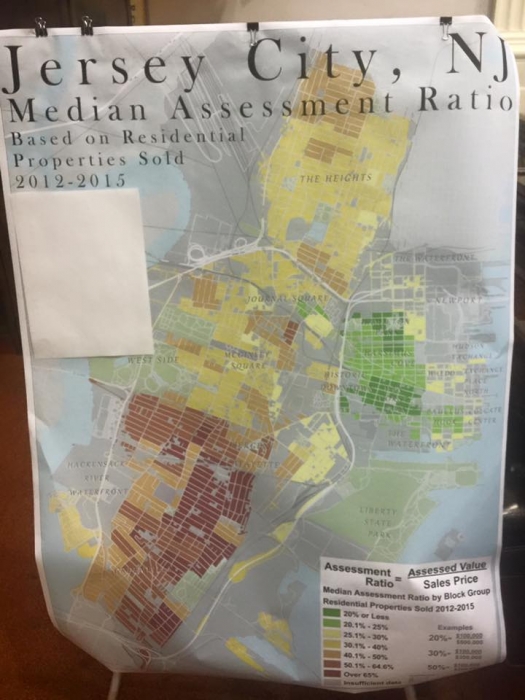Steve Fulop's callousness on state aid and property taxes
davidfrazer said:
I certainly agree that Abbott funding is a mess. I also think it was unfortunate that the "solution" was court-imposed rather than the result of legislative compromise. But the legislature has no one to blame but itself. The state of education in NJ's inner cities pre-Abbott was abysmal. Schools were literally crumbling. They were unsafe. Little or no education was going on. Tens of thousands of kids were being "left behind." No objective observer who surveyed the state of urban education in 1985 could conclude that inner-city kids were getting a constitutionally mandated "thorough and efficient" education. And, yet, the legislature, dominated by suburban interests, did nothing. Most city governments were corrupt, dysfunctional and with only a hollowed out tax base to rely on. The court was the only part of government willing and able to address the problem.
The legislature and various and sundry governors have had thirty years -- an entire generation -- to step up to the plate. They still haven't done so.
Thank you for bringing us back to the fact that most of the Abbott districts were underaided, underfunded, and suffering in the 1980s. Yes, the state needed to give its poorest districts more resources, but I differ with you on the appropriateness and affordability of the NJ Supreme Court's "Parity Plus Doctrine." Florio originally only wanted to give the urban poor districts money that would bring them up to the 60th percentile, but then the NJ Supreme Court joined the fray and ordered the state to fund the Abbott districts (and only the Abbott districts) ABOVE the average level of what the 100 richest districts were spending. It's the Parity Plus Doctrine which I see as unaffordable and directly (though not solely) responsible for the tax and budgetary disaster the state is facing. The fact that the NJ Supreme Court applied its remedy only to the Abbott plaintiffs is solely responsible for the grotesque aid and funding cliffs we have been low-resource/high-need non-Abbotts and the Abbotts, ie, the fact that Guttenberg, Dover, Red Bank Boro, Prospect Park, Lakewood etc get 20%-50% as much state aid as the Abbotts.
But this comes back to Jersey City: Jersey City isn't high-resource like most suburbs, but it has the ability to pay a lot more in taxes than it does. It's Local Tax Levy for schools is $109 million on $18+ billion in valuation. Jersey City's Local Tax Levy is basically the same as SOMA's, even though SOMA has $5.5 billion in valuation.
Even if you believe in the Parity Plus Doctrine you have to recognize that two-thirds of the Abbotts get Adjustment Aid, meaning they are overaided according to the state's own aid law, SFRA. The Total Adjustment Aid the Abbotts get is $400 million. That's money that can go to the pension debt and/or needier school districts.
This isn't fair and I am disturbed that Steve Fulop is so nonchalant about it.
JBennett, I agree with your issues with Jersey but find it highly problematic when you write:
"Also, the Abbott decision has been shockingly ineffective. High-poverty/low-resource non-Abbotts like Guttenberg, Dover, Red Bank Boro, and Belleville match or outperform their higher-resourced Abbott peers."
While some of these districts have significant levels of poverty, none of these districts have substantial presence of the historically most disadvantaged group--African-American students (15% at most, Guttenberg less than 2%). And two of districts are small going from only K-8. There is some validity to the point that high funding hasn't automatically translated into significantly improved performance but focussing on that is really simplistic. As I'm sure you'll agree there are many other factors in addition to level of school funding that's at play behind student performance.
Edited to fix typos.
xavier67 said:
JBennett, I agree with your issues with Jersey but find it highly problematic when you write:
"Also, the Abbott decision has been shockingly ineffective. High-poverty/low-resource non-Abbotts like Guttenberg, Dover, Red Bank Boro, and Belleville match or outperform their higher-resourced Abbott peers."
While some of these districts have significant levels of poverty, none of these districts have substantial presence of the historically most disadvantaged group--African-American students (15% at most, Guttenberg less than 2%). And two of districts are small going from only K-8. There is some may be validity to the point that high funding hasn't automatically translated into significantly improved performance, focussing on that is really simplistic. As I'm sure you'll agree there are many other factors in addition to level of school funding that's at play behind student performance.
I have been following this discussion with interest. A question for you, xavier67 - Are you saying that addressing the needs of African Americans (historically and currently disadvantaged) should be a higher priority than say addressing the needs of Latinos who are more recently disadvantaged?
I'm curious whether the Abbott decision was based on race or economic status or both? Sorry I am not very familiar with the history of the decision. Also, curious if the decision is reviewed periodically to assess whether certain areas still qualify for the aid and whether other areas that may have not qualified in the past, do so now?
"[Jersey City's] Local Tax Levy for schools is $109 million on $18+ billion in valuation. Jersey City's Local Tax Levy is basically the same as SOMA's, even though SOMA has $5.5 billion in valuation."--JBennett
Jersey City's PILOTs + Abbott + Hudson County = you can forget the "efficient" part of "thorough and efficient."
xavier67 said:
JBennett, I agree with your issues with Jersey but find it highly problematic when you write:
"Also, the Abbott decision has been shockingly ineffective. High-poverty/low-resource non-Abbotts like Guttenberg, Dover, Red Bank Boro, and Belleville match or outperform their higher-resourced Abbott peers."
While some of these districts have significant levels of poverty, none of these districts have substantial presence of the historically most disadvantaged group--African-American students (15% at most, Guttenberg less than 2%). And two of districts are small going from only K-8. There is some validity to the point that high funding hasn't automatically translated into significantly improved performance but focussing on that is really simplistic. As I'm sure you'll agree there are many other factors in addition to level of school funding that's at play behind student performance.
Edited to fix typos.
This is an important topic. You are right, the high-poverty/low-resource non-Abbotts tend to have more Latinos than the Abbotts, although the FRL-eligibility rates between high-poverty/low-resource non-Abbotts and Abbotts overlap and there are some Abbotts with very high Latino populations. (If you attribute the higher performance of the high-poverty/low-resource Abbotts to their having more Latinos, than Union City's (which is an Abbott) accomplishment (which was praised recently in a book Improbably Scholars by David Kirp) looks less impressive, since Union City is 96% Latino.)
I think overall that the financial differences between high-poverty/low-resource non-Abbotts and Abbotts are greater than their demographic differences.
From the comparisons I have looked at there is very little difference (if any) between these two groups of districts even when you account for non-economic demographic factors. There may be benefits to the high-spending in the Abbotts that don't appear in test scores, but judging from test scores the differences aren't there.
Compare Dover and Phillipsburg.
Dover is 69% FRL eligible and 82% Latino and 7% black. It's a non-Abbott and only spends $11,362 per student. It gets $350,000 for Pre-K, probably enough for 11-12 kids per grade.
Phillipsburg is 53% FRL-eligible and only 17% Latino and 13% black. It's an Abbott and spends $15,998 per student. All the kids there get Pre-K.
Based on the FRL and spending numbers, you would think that Phillipsburg would outperform Dover, but the opposite is true. Phillipsburg's schools score at the 37th percentile. Dover's schools score at the 53rd percentile. Dover, in fact, outperforms all of the Abbotts. Union City only scores at the 27th percentile.
Compare East Newark and Hoboken.
East Newark is the most underresourced district in NJ. It spends $9,980 per student and is 88% FRL-eligible. It is 86% black or Latino. 65% of students speak Spanish at home. It gets $41,680 for Pre-K, maybe enough for two kids per grade?
Then there is Hoboken, the second highest spending K-12 district in NJ after Asbury Park, at over $22,199 per student. Even with the demographic distortion of Hoboken's charter schools, Hoboken's public school students are 49% FRL eligible and 95% speak English at home. All the kids get Pre-K.
Who would expect East Newark to underperform Hoboken since its spending is less than half of Hoboken's and its FRL-numbers are so much higher, but their performance is equal. Hoboken's students perform at the 19th percentile. East Newark's are at the 20th percentile.
The NJ DOE did a comprehensive comparison between the Abbotts and high-poverty/low-resource non-Abbotts and found likewise little or no difference. (Look at the charts on pages 25 and 26)
http://www.nj.gov/education/stateaid/1213/report.pdf
While the above analysis is not sufficient to say whether new spending has had a positive impact on student achievement, it makes clear that financial resources are not the only – and perhaps not even the most important – driver of achievement. On the one hand, we observe economically disadvantaged districts that perform at a level higher than that of their counterparts, but at a substantially lower cost per-student. On the other hand, some of the highest-spending districts made almost no progress closing the achievement gap with the rest of the State. After decades of evidence, it is clear that money alone is not the solution to the persistent and unacceptably low performance in our State’s neediest districts.
Xavier, you might be onto something about the non-Abbotts being smaller than the Abbotts. If that's the case than what the state should do is try to provide that small school experience to kids in the Abbotts rather than focus on money.
I'm NOT saying that money doesn't matter. One reason I am making these arguments is because I cannot stand how the state underfunds East Newark, Dover, Prospect Park, Belleville, Guttenberg, Lakewood etc. However, there is a point where you get into diminishing returns territory and more money doesn't seem to help. The Abbotts seem to be beyond the point of diminishing returns and cuts to the Abbotts (which would free up more money for pensions and low-resource non-Abbotts should be on the table, especially when the Abbott is like Jersey City and gets Adjustment Aid.
Unlike the Education Law Center, which is blind to the state's economic reality, I know that the state has a monstrous deficit and therefore I favor redistribution of aid rather than just somehow finding billions of dollars more a year for SFRA.
dg64 said:
I'm curious whether the Abbott decision was based on race or economic status or both? Sorry I am not very familiar with the history of the decision. Also, curious if the decision is reviewed periodically to assess whether certain areas still qualify for the aid and whether other areas that may have not qualified in the past, do so now?
The Abbott list is based on a list the state compiled back in the early 1980s of "urban districts," but with high-resource poor urban districts removed (ie, Atlantic City has never been an Abbott). At the time of the 1990 Abbott II decision there were 28 Abbotts, now there are 31.
The NJ Supreme Court doesn't set the list of Abbott districts. The governor and legislature do. The legislature added three small rural districts to the original Abbott list (most recently Salem City) and once removed Plainfield, but then put Plainfield back on. The legislature fully has the power to remove Hoboken from the list, but it chooses not to presumably because of inertia and powerful Hudson County interests.
Technically the Abbott designation doesn't exist anymore. SFRA supposedly treats all districts equally depending on their resources and the percentage of "at risk" students. However, the NJ Supreme Court blocked any cuts to the Abbott districts in 2011 and the Abbotts are still the only districts to get universal Pre-K. The non-Abbotts usually get pittances for Pre-K. Therefore I think it is perfectly legitimate to use the term "Abbott district" even if it doesn't have the legal meaning it had before SFRA was passed.
@JBennett - do your numbers control for special ed and capital/building maintenance costs?
Steve said:
@JBennett - do your numbers control for special ed and capital/building maintenance costs?
No, I did not take these numbers into account. Special education numbers are subjective and exhibit a lot of variation between demographically similar districts. For this reason the state doesn't attempt to use sped percentages in its formulas for state aid.
To demonstrate how sped percentages vary, consider that 8% of Irvington's students are classified as having special needs, but 10% of the SOMSD's students are, while 18% of Essex Fells' students are.
If you are curious, sped numbers are available on the ELC and DOE's websites.
http://education.state.nj.us/pr/
http://www.edlawcenter.org/research/data-research.html
FWIW, the numbers are:
East Newark is 12%. Hoboken is 10%. Dover 9%. Phillipsburg 13%. I would not attribute any score difference to official sped classification.
Capital costs are a separate budget line and not factored into the Per Pupil Spending figures that I used. If you are curious about Per Pupil expenditures and many other budget lines they are available in the User Friendly Budgets. The budget figures I used didn't use retiree costs like pensions. If you use those figures the per pupil costs are much higher for all districts.
Abbott districts get 100% of their capital costs covered by the state anyway, so if I had factored this in the aid advantages of the Abbotts would be much higher.
Thanks. I was not speaking to special ed populations, but to special ed costs. As you are fully aware, the costs of special ed are consuming an ever larger portion of our school budget. I'd be interested in seeing the per pupil expenditures for the general ed population on a district by district comparison because, as you also know, a few special ed students can disproportionately alter the "per pupil" expenditures in a smaller district.
Jeff
Thanks for all your hard work on this but I wonder if the percentile rankings give an accurate picture? By definition, some district is going to be 99th percentile and some district is going to be 1st percentile, even if they are all performing at Millburn-like levels. Say in 2010 two districts were at the 19th and 28th percentiles and in 2015 were still at those same percentiles. It is entirely possible that these districts both improved [or declined] in absolute terms. Relative rankings can obscure what's really going on.
davidfrazer said:
Jeff
Thanks for all your hard work on this but I wonder if the percentile rankings give an accurate picture? By definition, some district is going to be 99th percentile and some district is going to be 1st percentile, even if they are all performing at Millburn-like levels. Say in 2010 two districts were at the 19th and 28th percentiles and in 2015 were still at those same percentiles. It is entirely possible that these districts both improved [or declined] in absolute terms. Relative rankings can obscure what's really going on.
It would be too much for me to try to track score change over the years, but the NJ DOE in the 2012 Adequacy Report suggested that there was no difference in score improvement.
I know what you mean about relative rankings. I use them because it's all I have, but if the theory of Abbott is correct, than high relative spending should translate, somehow, into better relative performance. That the high-poverty/low-resource non-Abbotts appear to be at the same relative position (or better) than the Abbotts makes me question the theory of the Abbott decision.
Where my conclusions could be wrong is if the Abbotts have more deep poverty than the non-Abbotts I've compared them too. I've made no attempt to compare Free Lunch eligibility rates and have used the aggregated Free & Reduced Lunch rates.
The Abbott decision was well-intentioned. To a degree, the focus on funding was a response to the legal impossibility of integration through interdistrict student transfers. The architects of Abbot presumably didn't want the state to create a U-shaped aid distribution where the wealthy districts and Abbott districts spent large amounts of money and districts in the middle (including many with high poverty too) spent very little. The Abbott architects wanted a flatter distribution with a tilt to the poorer districts, not a steep-sided canyon distribution.
But politics is politics and the Abbott ideal wasn't realizable and the funding theory hasn't worked. At this point of state fiscal emergency I think everything has to be on the table, including cuts to the Abbott districts and especially the Abbotts that get Adjustment Aid.
I have a follow up on this:
http://politickernj.com/2015/07/doherty-tells-fulop-to-step-up-his-game-rather-than-sling-mud/
Doherty has as many criticisms of Christie as he has of Fulop. Doherty criticizes Fulop for refusing to follow through on doing a reevaluation.
Although irritated by Fulop’s answer to the criticism [ie, "it's creepy to ask"], Doherty said he doesn’t blame him so much as Republican Governor Chris Christie. “This issue should have been confronted by Governor Christie,” said the Warren-based Senator. “This is the classic opportunity for Chris Christie to step in, but unfortunately it’s not a top priority. Everyone’s supposed to play by the same set of rules and Jersey City is not. In Jersey City, the per capita income is higher than one of my towns – Hackettstown – but Jersey City gets 70% of its school budget paid for by New Jersey taxpayers while Hackettstown gets 16%.”
“All these Wall Street people are living in Jersey City,” Doherty said. “If Steve Fulop wants to run for governor he needs to get out of Jersey City and see how the rest of us live. He needs to step up his game. He lives in a Democrat fishbowl and he’s allowed to get away with this mentality but he needs to consider that there are people struggling to pay the tax bill outside of Jersey City and they’re really pissed off. For the life of me I don’t know why Christie doesn’t go after him.”
Thought I read recently that Jersey City was the biggest city in NJ, in terms population (voters). Big donor class there, too.
Some people have told me that I shouldn't hold it against Steve Fulop that he supports a grossly unfair distribution of state aid because, as mayor of Jersey City, it's his job to support anything that benefits his city, even if matter is unjust. People tell me that if Fulop were governor he might be fairer since then then his constituents would be all of New Jersey and not just Jersey City.
But Steve Fulop already doesn't govern in the interests of all of the constituents he already has. He has consistently opposed a reval in JC since before he became mayor, even though Jersey City hasn't done a reval since 1988 and it has the state's worst Coefficient of Deviation. (the measure of tax unfairness.)
In opposing a reval, Steve Fulop is acting like the mayor of downtown Jersey City, not the entire city.
Anyway, watch this clip of Fulop talking about the reval which the state is now forcing JC to conduct. Watch at minute 10:50, when Fulop is asked "We're asking you to lead as mayor of the entire city. .... Will you support a revaluation of taxes in Jersey City?" and Fulop tells the audience (who I'm guessing based on the location of the church mostly aren't from a gentrified part of JC and are therefore overpaying taxes) that he is against a reval because he wants to "save their homes." (the audience refuses to believe SF's baloney.)
https://www.youtube.com/watch?v=XR1f2qS6zvA&feature=youtu.be
This unfairness is what Steve Fulop is defending.
I don't have the skills to produce a map like this showing state aid excesses and deficits, but if someone could produce one you would get the same effect.
What I have seen so far from Fulop is not impressive. If he wants to be Governor, he has a long way to go.
Featured Events
-
Go "Back to the '70s" with The Maplewood Glee Club and Special Guests from CHS
May 19, 2024 at 4:00pm
For Sale
-
2007 Honda Fit $4,400
More info




























I'm a boomer, although perhaps not fitting the stereotype, but I'm not seeing what the turn of generations is going to do to get us out of this. Unfortunately, we are seeing the downside of "compounding" in action.